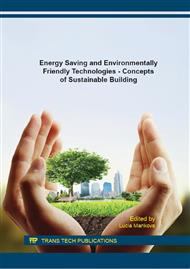[1]
ČSN 73 0540-2, Thermal protection of buildings - Part 2: Requirements. Prag: Úřad pro technickou normalizaci, metrologii a státní zkušebnictví, (2011).
Google Scholar
[2]
ČSN EN ISO 13 791, Thermal performance of buildings - Calculation of internal temperatures of a room in summer without mechanical cooling - General criteria and validation procedures. Prag: Úřad pro technickou normalizaci, metrologii a státní zkušebnictví, (2012).
DOI: 10.3403/30114649
Google Scholar
[3]
ČSN EN ISO 13 792, Thermal performance of buildings - Calculation of internal temperatures of a room in summer without mechanical cooling - Simplified methods. Prag: Úřad pro technickou normalizaci, metrologii a státní zkušebnictví, (2012).
DOI: 10.3403/30202120
Google Scholar
[4]
ČSN 73 0540-3, Thermal protection of buildings - Part 3: Design value quantities. Prag: Český normalizační institut, (2005).
Google Scholar
[5]
SIMULACE 2010, Svoboda Software, Kcad, (2010).
Google Scholar
[6]
TRNSYS 16, Transient System Simulation Tool, Solar Energy Laboratory, University of Wisconsin, Madison, USA, (2006).
Google Scholar
[7]
ČSN EN ISO 15927-4, Hygrotermal performance of buildings - Calculation and presentation of climatic data - Part 4: Hourly data for assesing the annual energy use for heating and cooling (ISO 15927-4: 2005). Prag: Úřad pro technickou normalizaci, metrologii a státní zkušebnictví, (2011).
DOI: 10.3403/30114395
Google Scholar
[8]
ČSN 73 0540-4, Thermal protection of buildings - Part 4: Calculation methods. Prag: Český normalizační institut, (2005).
Google Scholar
[9]
PEREZ, R., R. SEALS, P. INEICHEN, R. STEWART, D. MENICUCCI. A new simplified version of the Perez diffuse irradiance model for tilted surfaces. Solar Energy. Vol. 39, No. 3. 1987: pp.221-232.
DOI: 10.1016/s0038-092x(87)80031-2
Google Scholar
[10]
LOUTZENHISER, P.G., H. MANZ, C. FELSMANN, P.A. STRACHAN, T. FRANK a G.M. MAXWELL. Empirical validation of models to compute solar irradiance on inclined surfaces for building energy simulation. Solar Energy. 2007, (81): pp.254-267.
DOI: 10.1016/j.solener.2006.03.009
Google Scholar
[11]
LANINI, F. Division of Global Radiation into Direct Radiation and Diffuse Radiation. Bern, CH, 2010. Master's Thesis. University of Bern.
Google Scholar
[12]
REINDL, D.T., W.A. BACKMAN a J.A. DUFFIE. Diffuse Fraction Correlations. Solar Energy. 1990, (Vol. 45, No. 1. ): pp.1-7.
DOI: 10.1016/0038-092x(90)90060-p
Google Scholar
[13]
HELBIG, N. Application of the Radiosity Approach to the Radiation Balance in Complex Terrain. Zürich, CH, 2009. Dissertation. Universität Zürich.
Google Scholar


